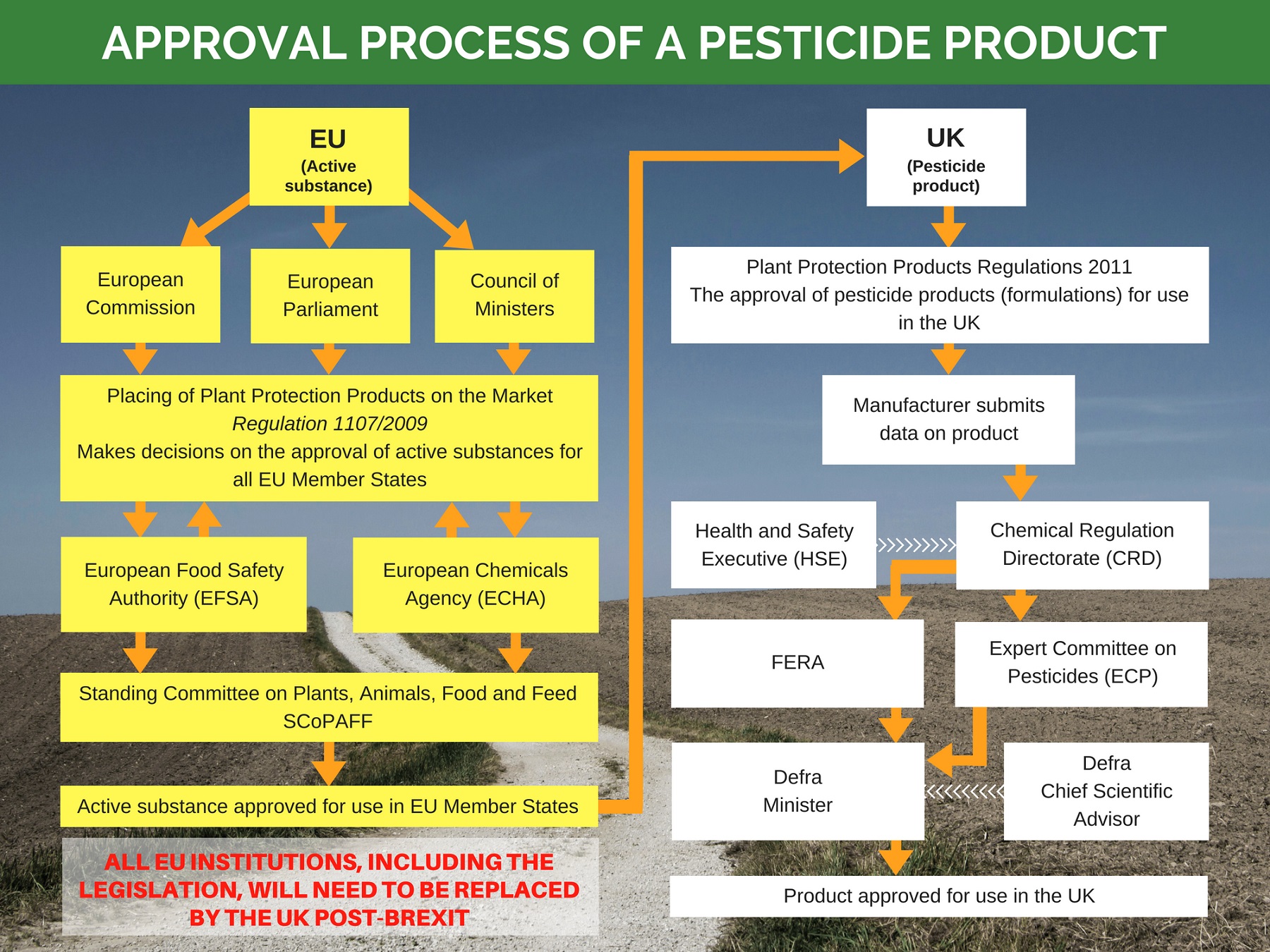How are pesticides currently regulated in the UK?
Pesticides are currently regulated through a variety of EU and UK laws. In order to ensure these laws are implemented, numerous European and UK bodies and institutions are involved. At the European level the key agencies responsible for governing pesticides include the European Chemicals Agency (ECHA) and the European Food Safety Authority (EFSA), in addition to the European Commission and Parliament which also play a role.
When we leave the EU therefore, we aren’t just facing losing the laws themselves but also the institutions which apply them (this is known as the ‘governance gap’). The UK must make sure to replace the functions of these bodies if we want our pesticide regime to work properly.
There are three main areas of pesticide policy which are regulated:
1. How pesticides are licensed – ‘authorisations’
Pesticides that can be sold and used have to first be authorised. Currently, active substances (the chemically active part of a manufactured product) is authorised at the European level. This authorisation has to take place before an active substance can be sold and then again at regular intervals for as long as it is on the market.
A range of EU institutions are involved in authorising active substances. Their role is to ensure that the process is carried out transparently and independently so that decisions are based on scientific evidence and protect human health and the environment from harm, while still enabling farmers to access pesticides. The UK does not currently have the capacity to manage its own process for authorising active substances, therefore, Brexit leaves us with a deeply concerning governance gap.
Once an active substance has been authorised it is then up to individual Member States to decide whether to authorise particular pesticide formulations (also known as pesticide products). The UK has always managed this process and this will not change due to Brexit.
Key European law: Placing of Plant Products on the Market Regulation 1107/2009
Key existing UK law: Plant Protection Regulations (2011)
UK regulating body: Health and Safety Executive (HSE)

2. How and where pesticides can be used
The EU also sets out rules for how and where pesticides can be used in the UK. The aim of these rules is to ensure that pesticides are used in a sustainable way, reducing risks and impacts on human health and the environment.
This area of pesticide regulation covers issues such as: what training is required for users; how application equipment should be maintained and inspected; measures to protect water and aquatic life from contamination; and how pesticides should be stored and handled.
The UK has already transposed the key EU directive on this area of pesticide policy into national law and was also obliged to create a National Action Plan for the Sustainable Use of Pesticides in 2012. There is also a UK-specific Code of Practice and various other guidance for pesticide users.
As a result Brexit should not result in huge gaps in either legislation or governance.
Key EU law: Directive on the Sustainable Use of Pesticides (SUD) 2009/128/EC
Key existing UK laws and guidelines:
- Plant Protection Products (Sustainable Use) Regulations 2012
- National Action Plan for Pesticides (2012)
- Code of Practice for Using Plant Protection Products
- Guidance for all uses of pesticides
UK regulating body: Department for Environment, Food and Rural Affairs (DEFRA) and Health and Safety Executive (HSE)
3. How pesticides affect food
Pesticides used in agriculture will often be detectable as residues in food. The EU sets what are known as ‘Maximum Residue Levels’ for each individual active substance that is authorised for use. The Maximum Residue Level will be different depending on the food item (for example the maximum residue level of the fungicide Imazalil allowed on apples will be different to pears). The EU is responsible for setting, monitoring and updating tens of thousands of individual Maximum Residue Levels.
These Maximum Residue Levels (MRLs) apply to both produce grown within the EU and produce that is imported. If food is found to contain residues above the Maximum Residue Level it cannot be sold within the EU. Similarly, if the residue of an active substance that has been banned in the EU is detected then the food cannot be sold.
Currently, the UK has no capacity to take on the mammoth task of setting our own Maximum Residue Levels. Rather than invest the considerable time and money this would require, we may decide to stick to those set by the EU. Another option would be to default to the Maximum Residue Levels set by the Codex Alimentarius which sits under the UN’s Food and Agriculture Organisation. However, these tend to be less stringent than those set by the EU, meaning that UK citizens could soon be facing higher levels of pesticide residues in our food.
Key European law: EU Regulation 396/2005 on Maximum Residue Levels of Pesticides in or on food and feed of plant and animal origin
Key existing UK law: None
